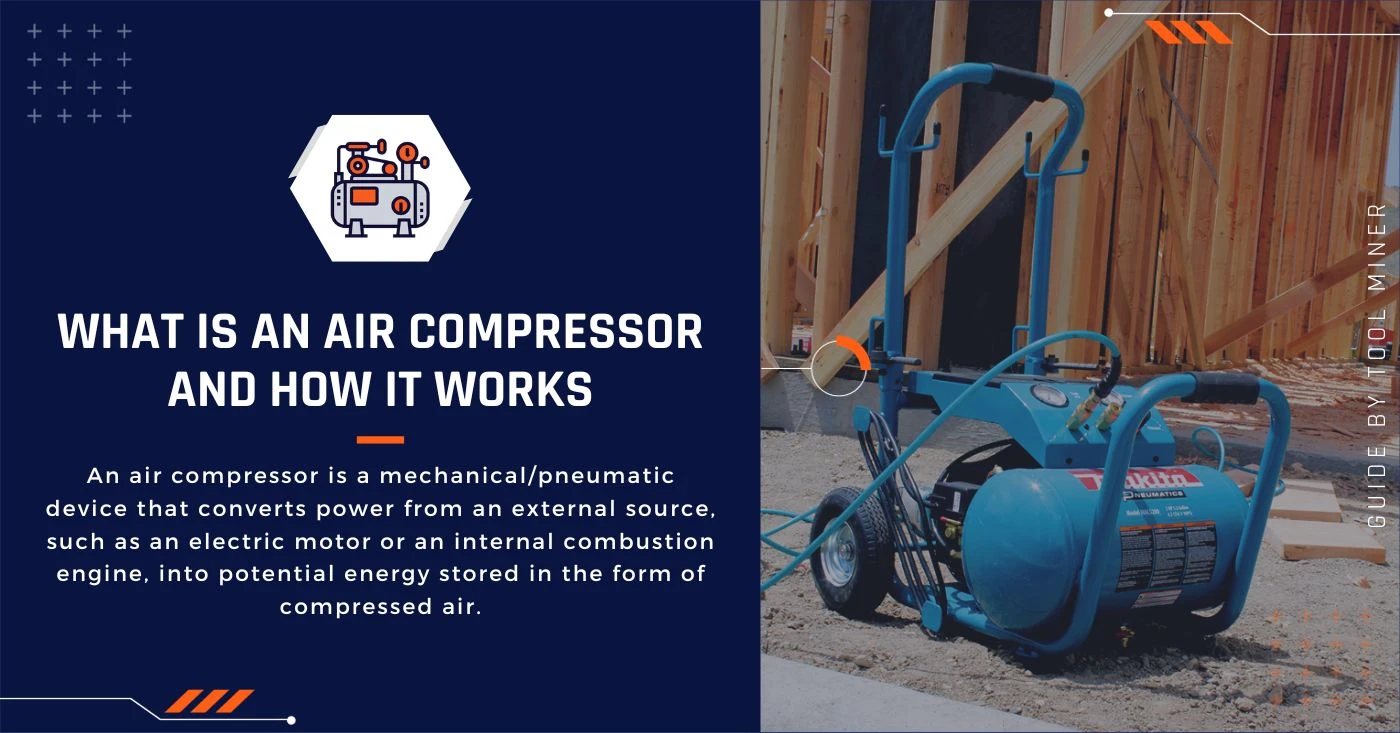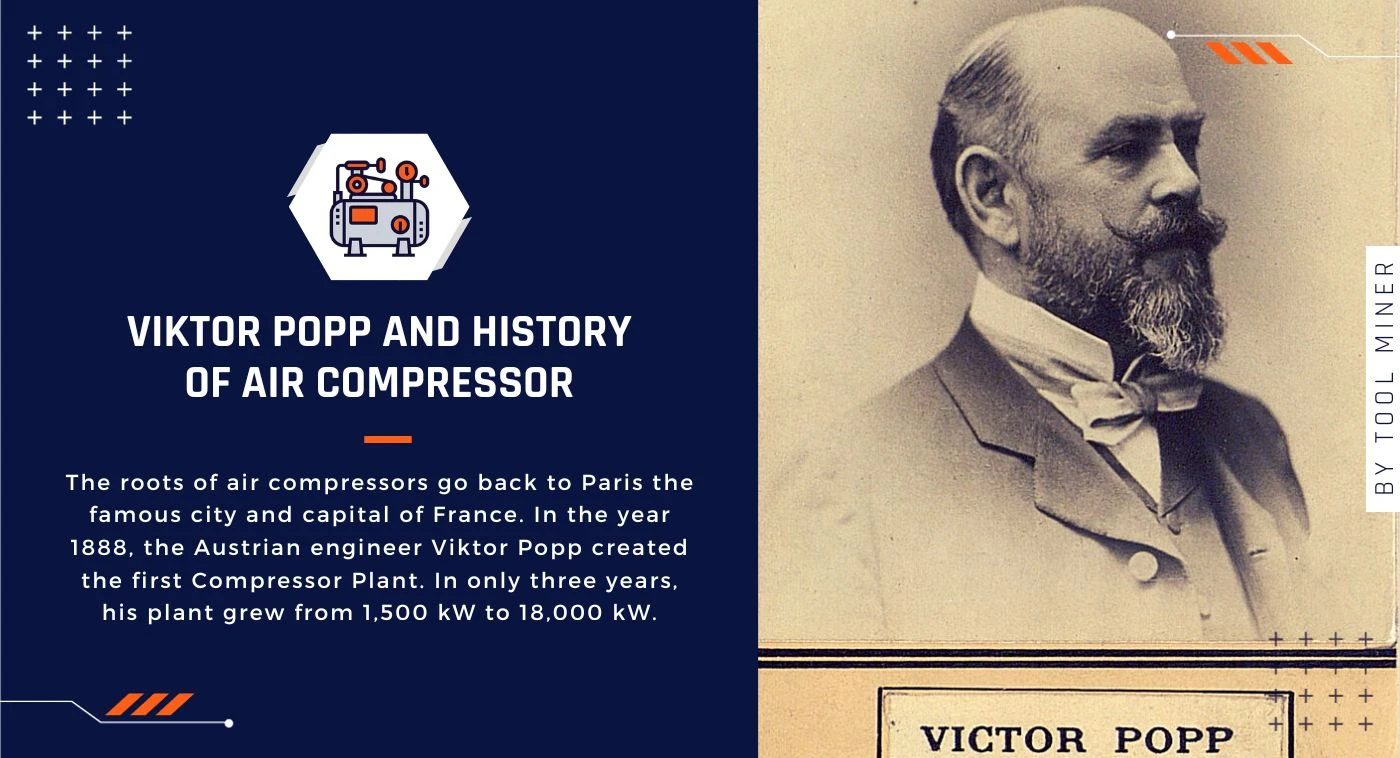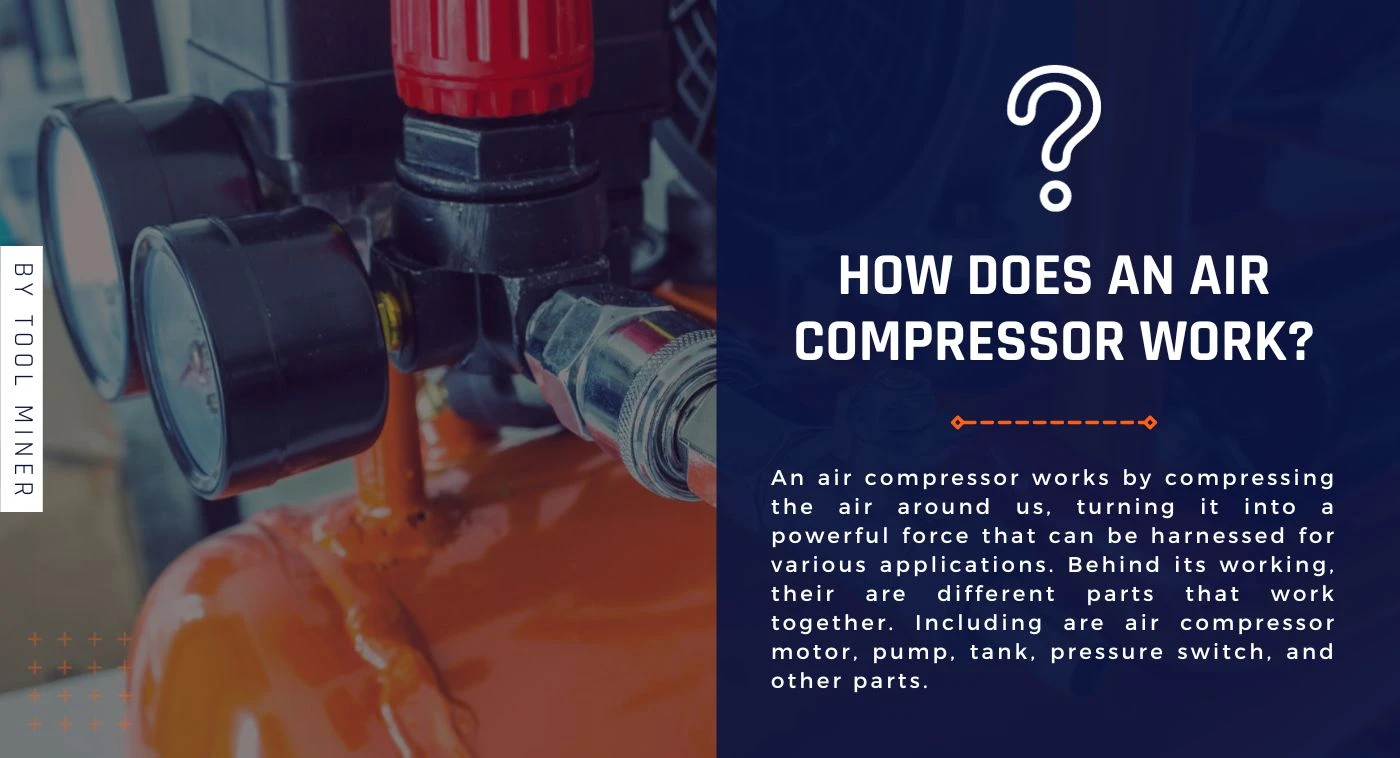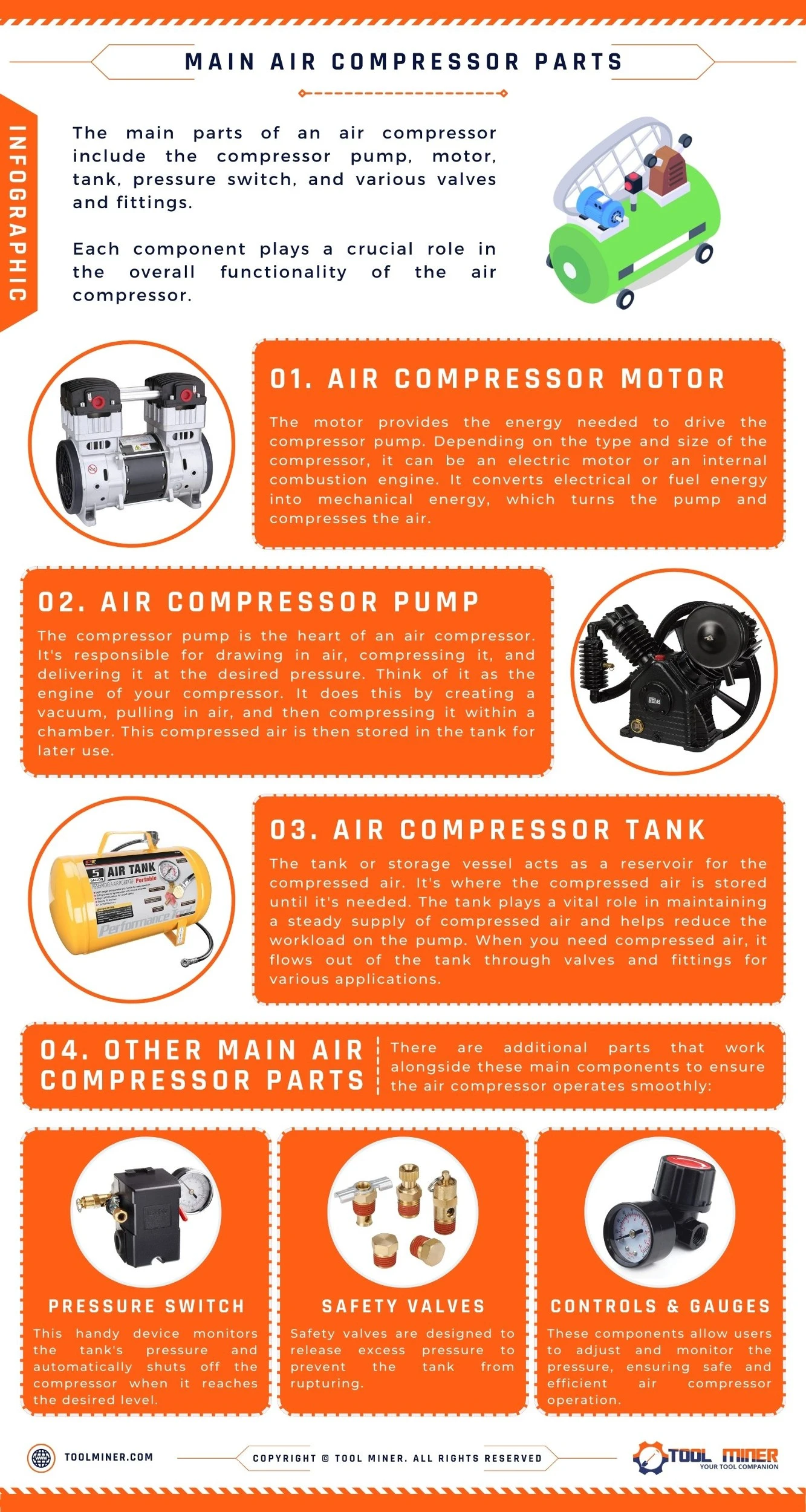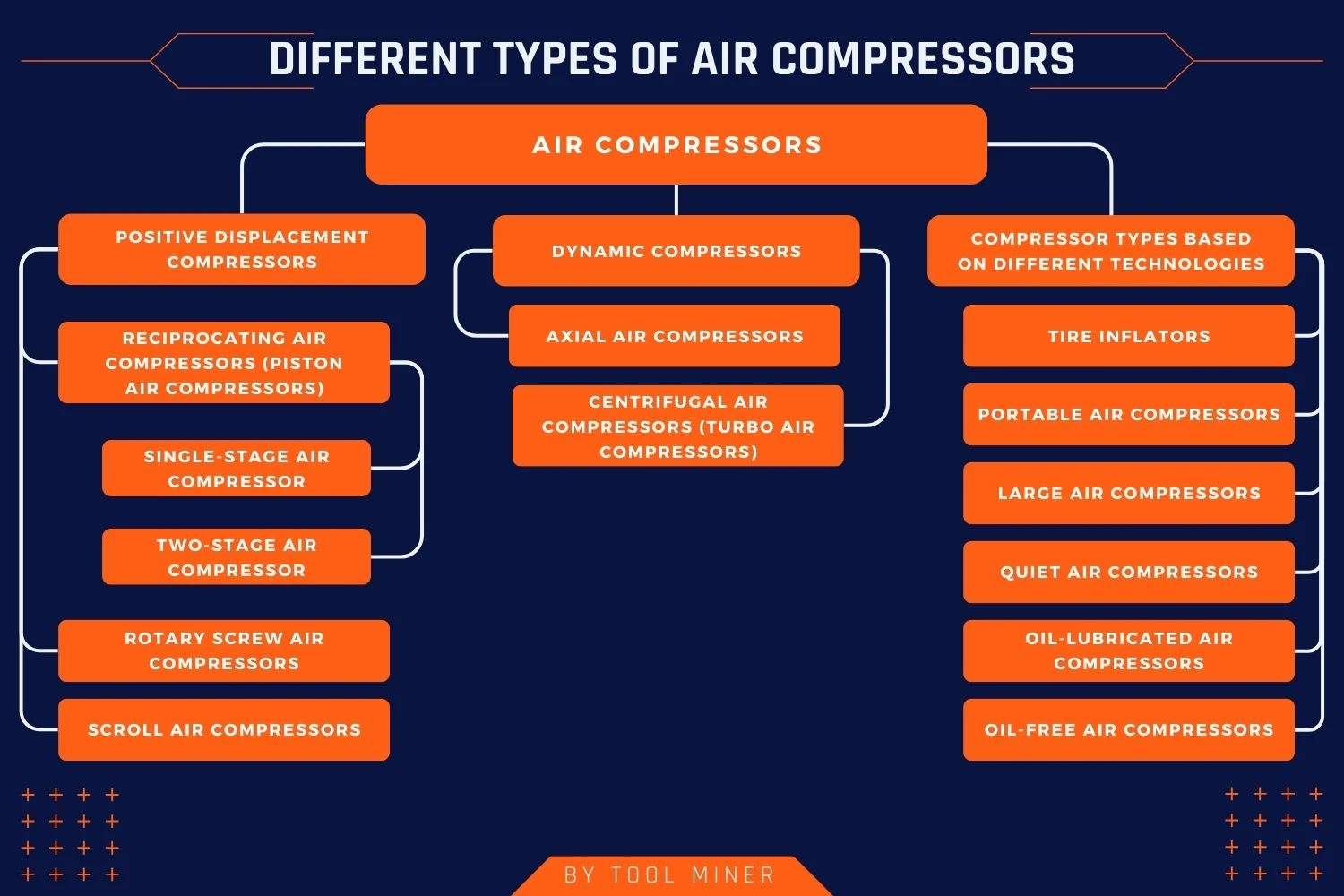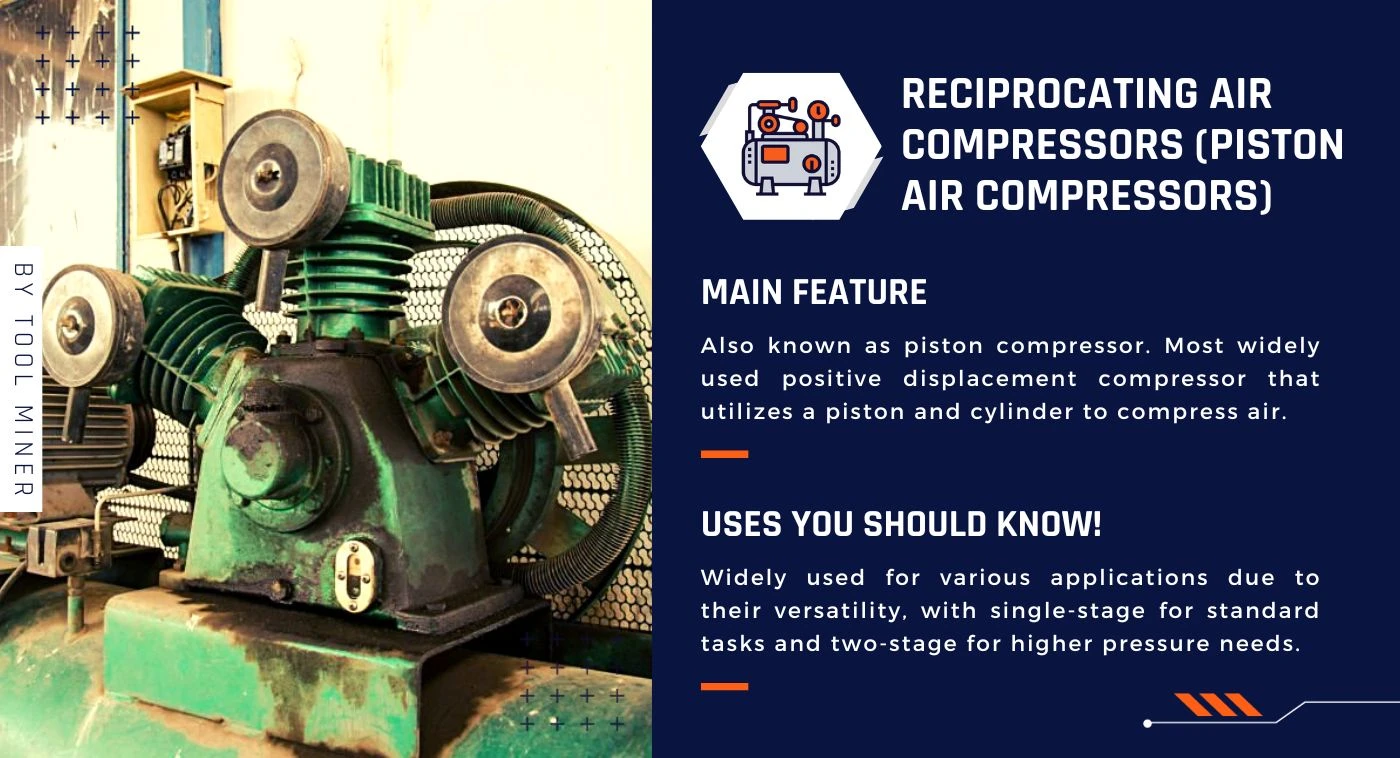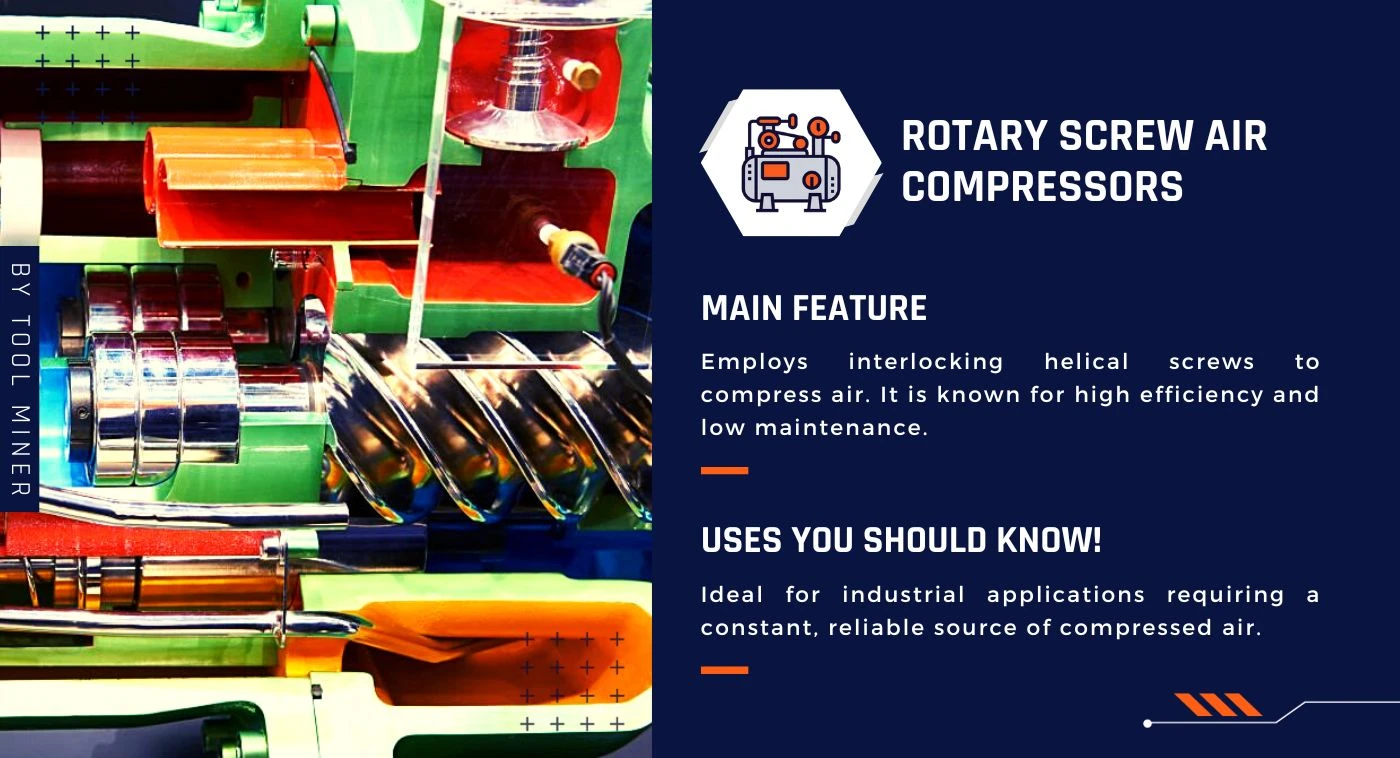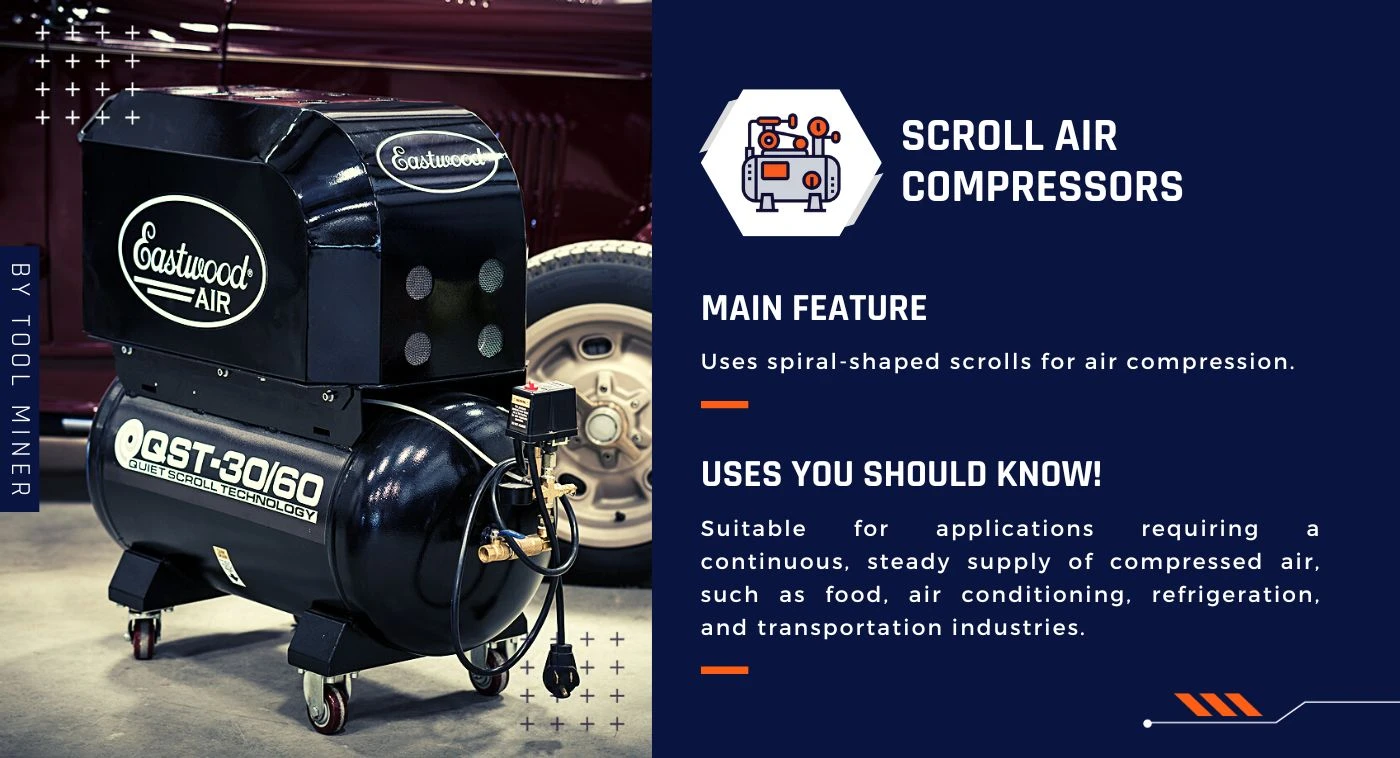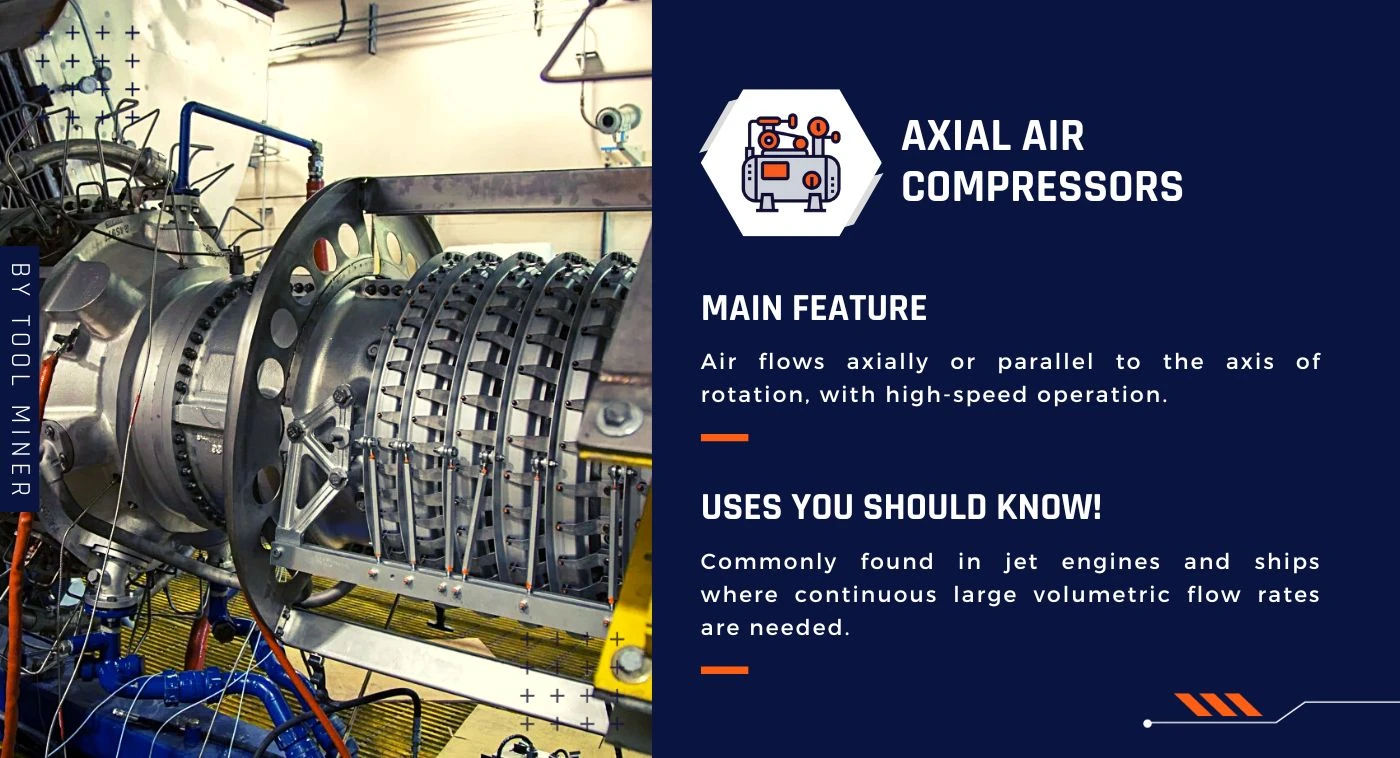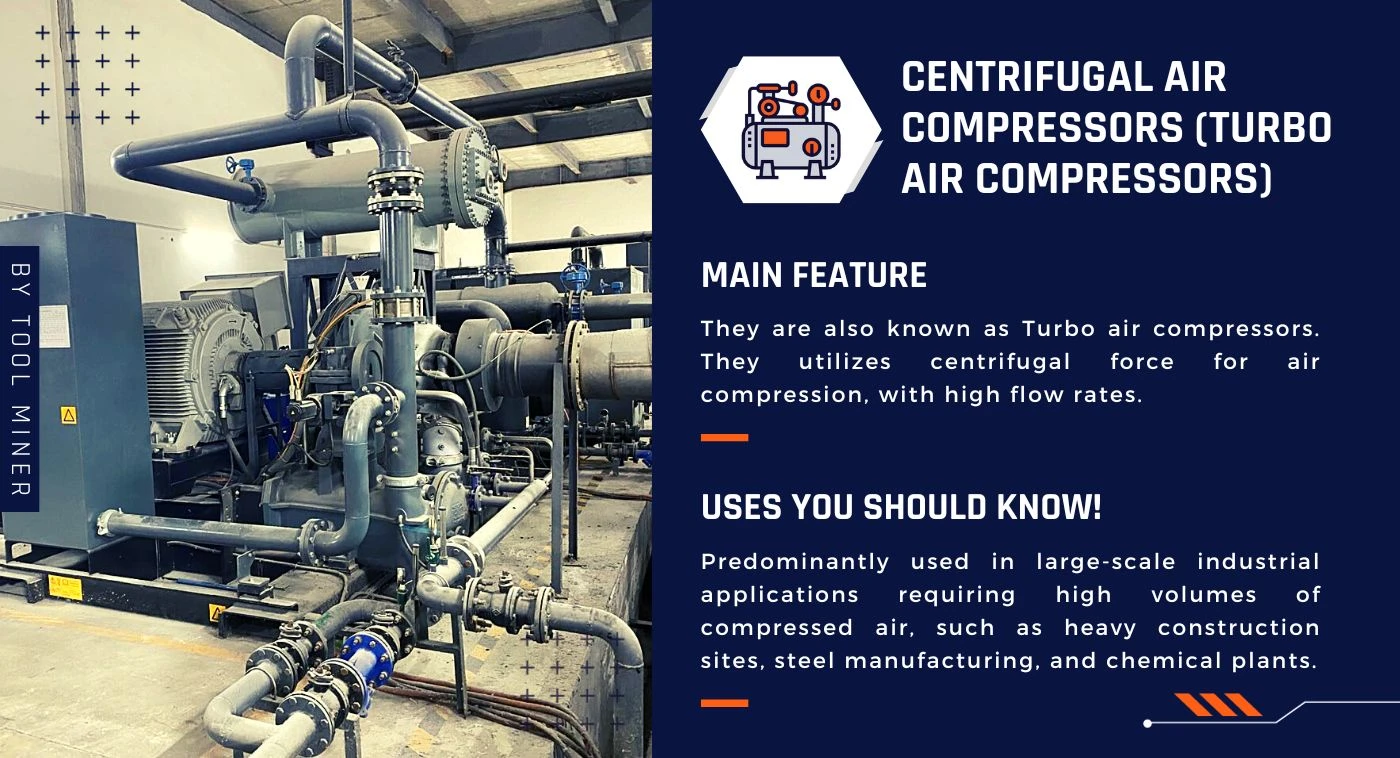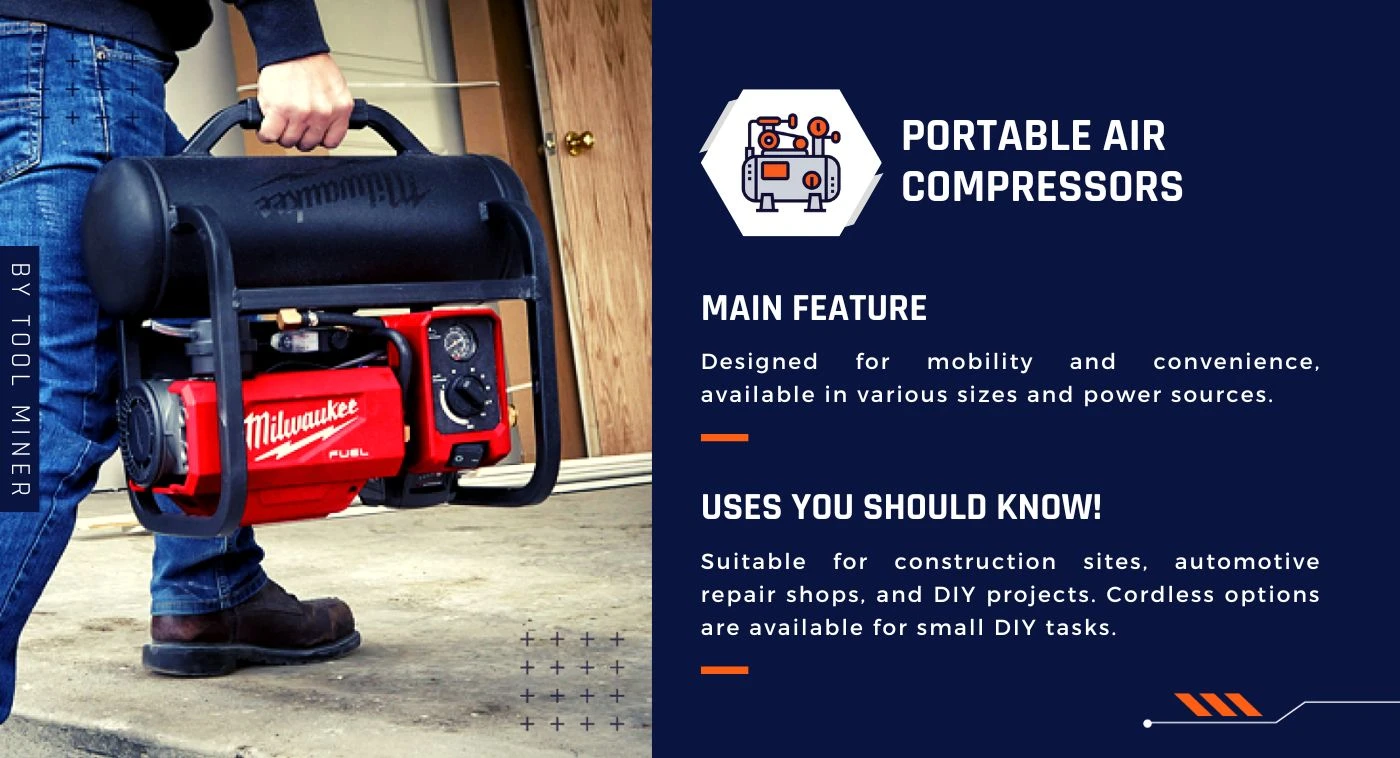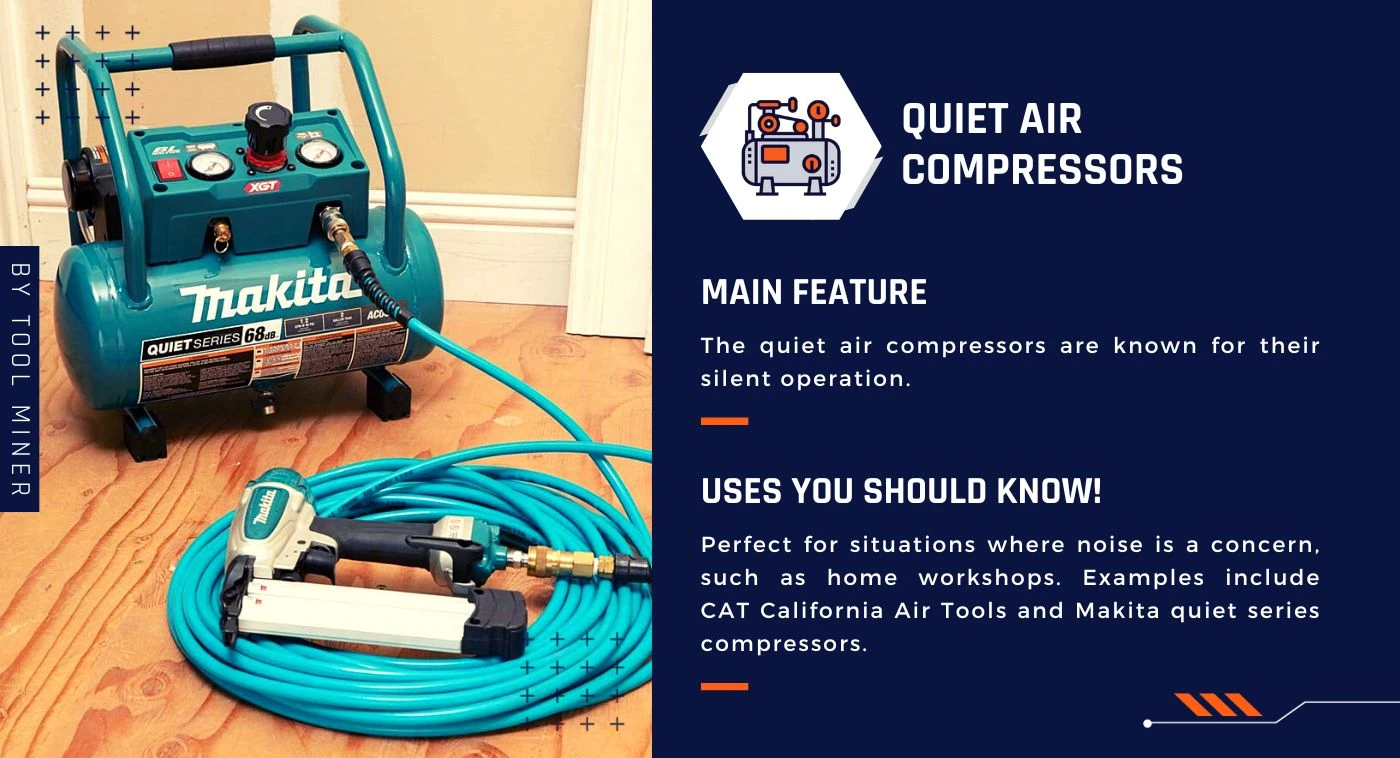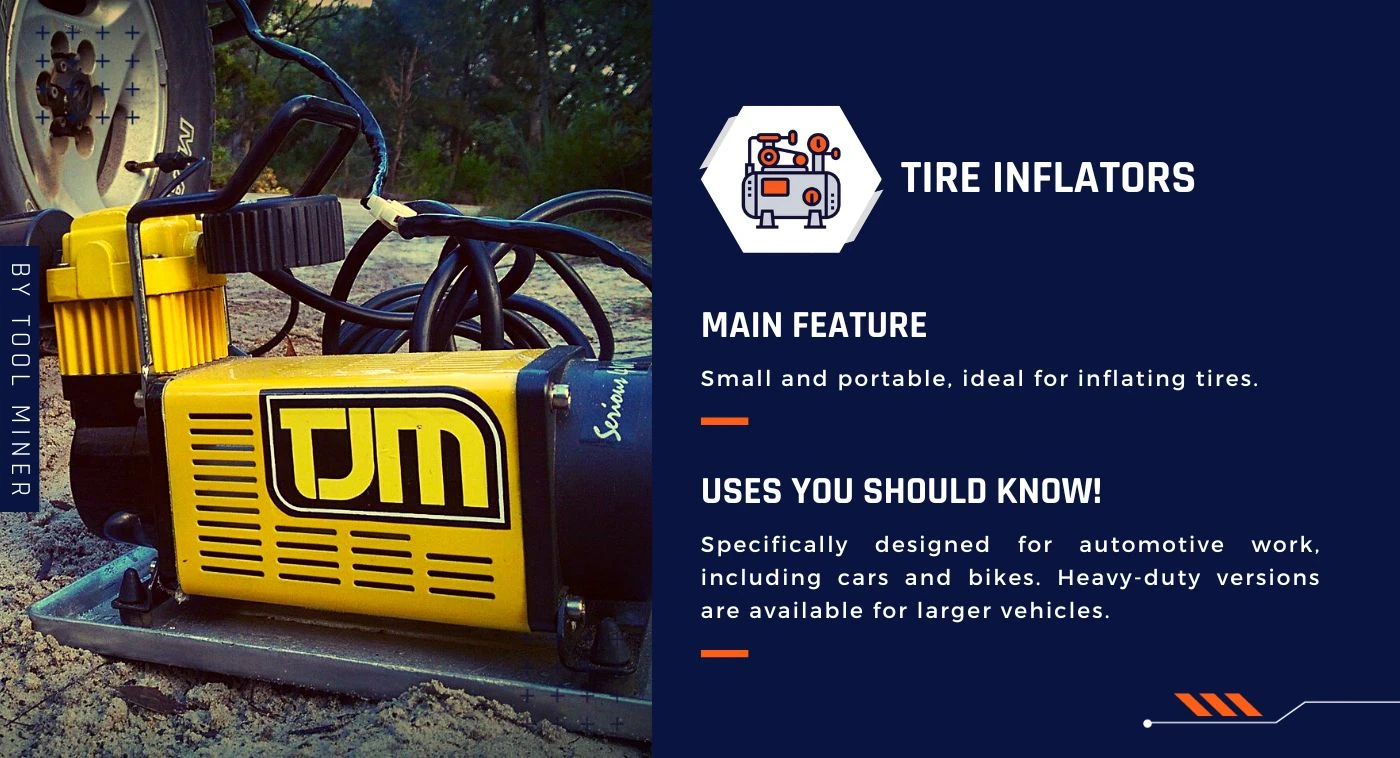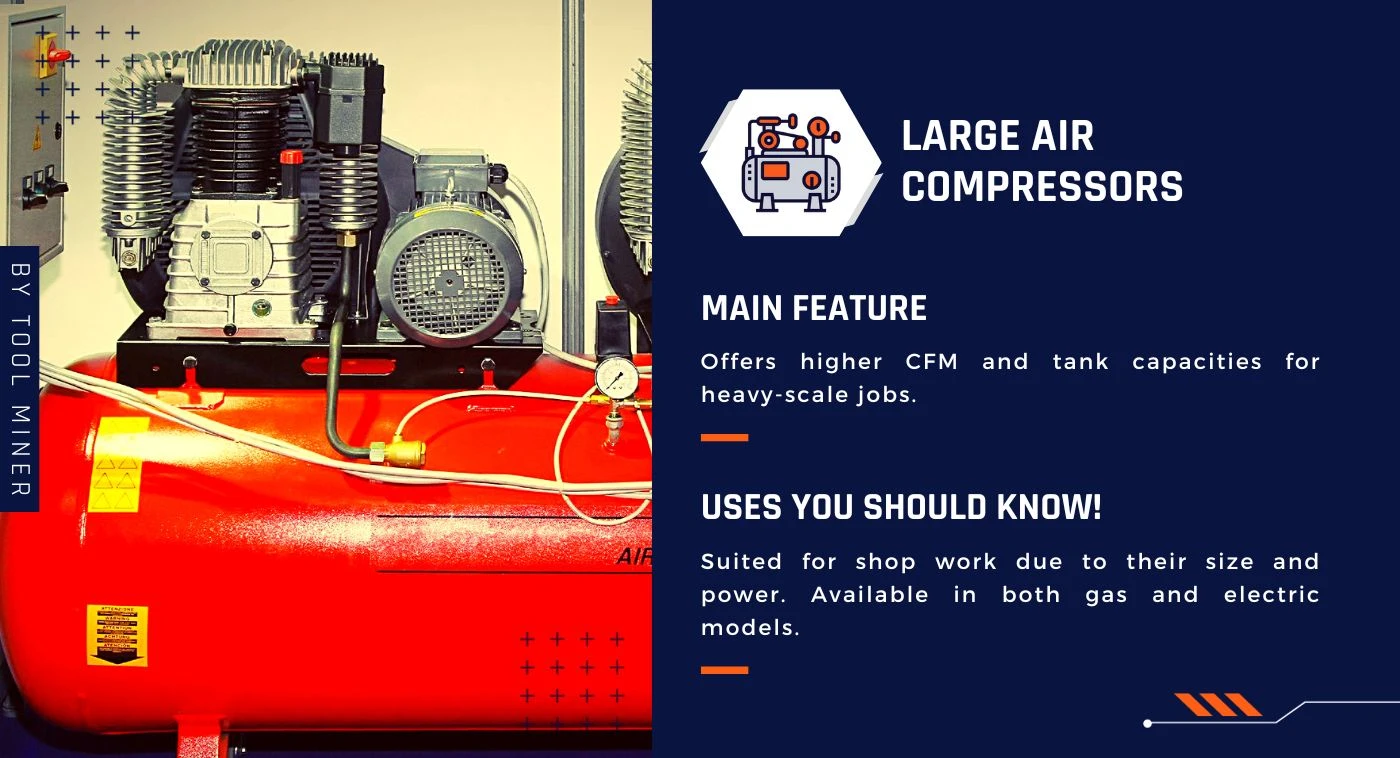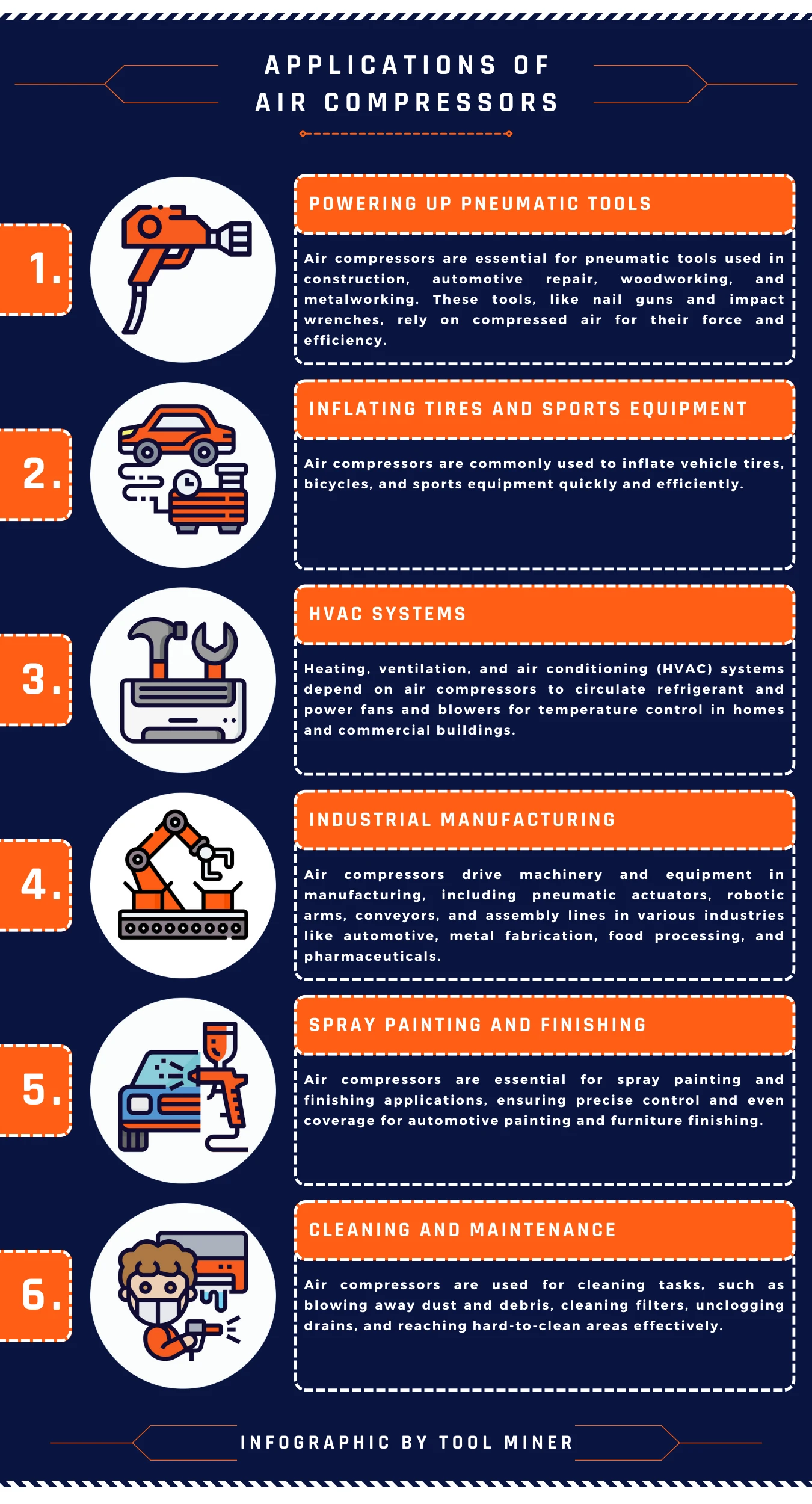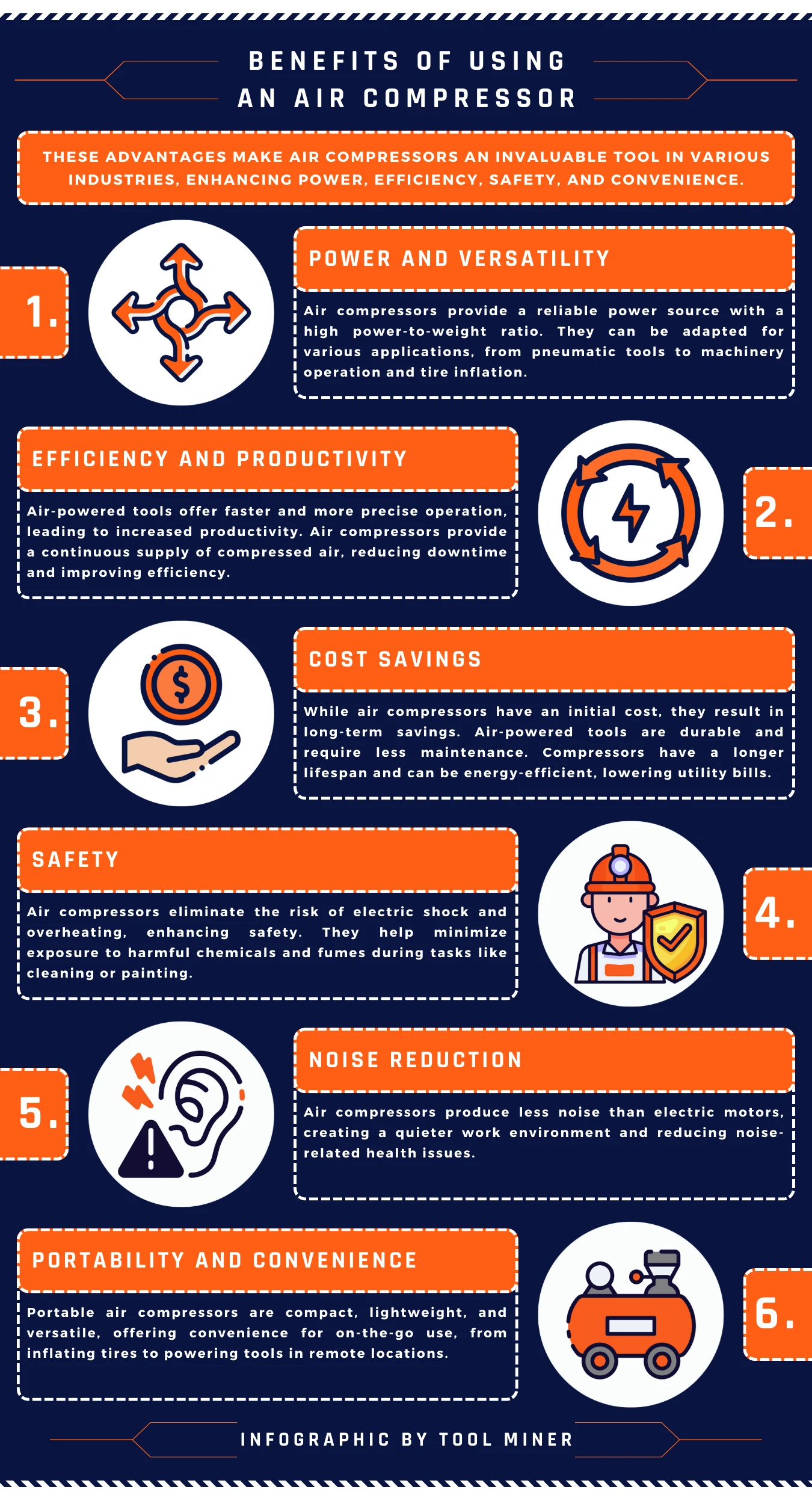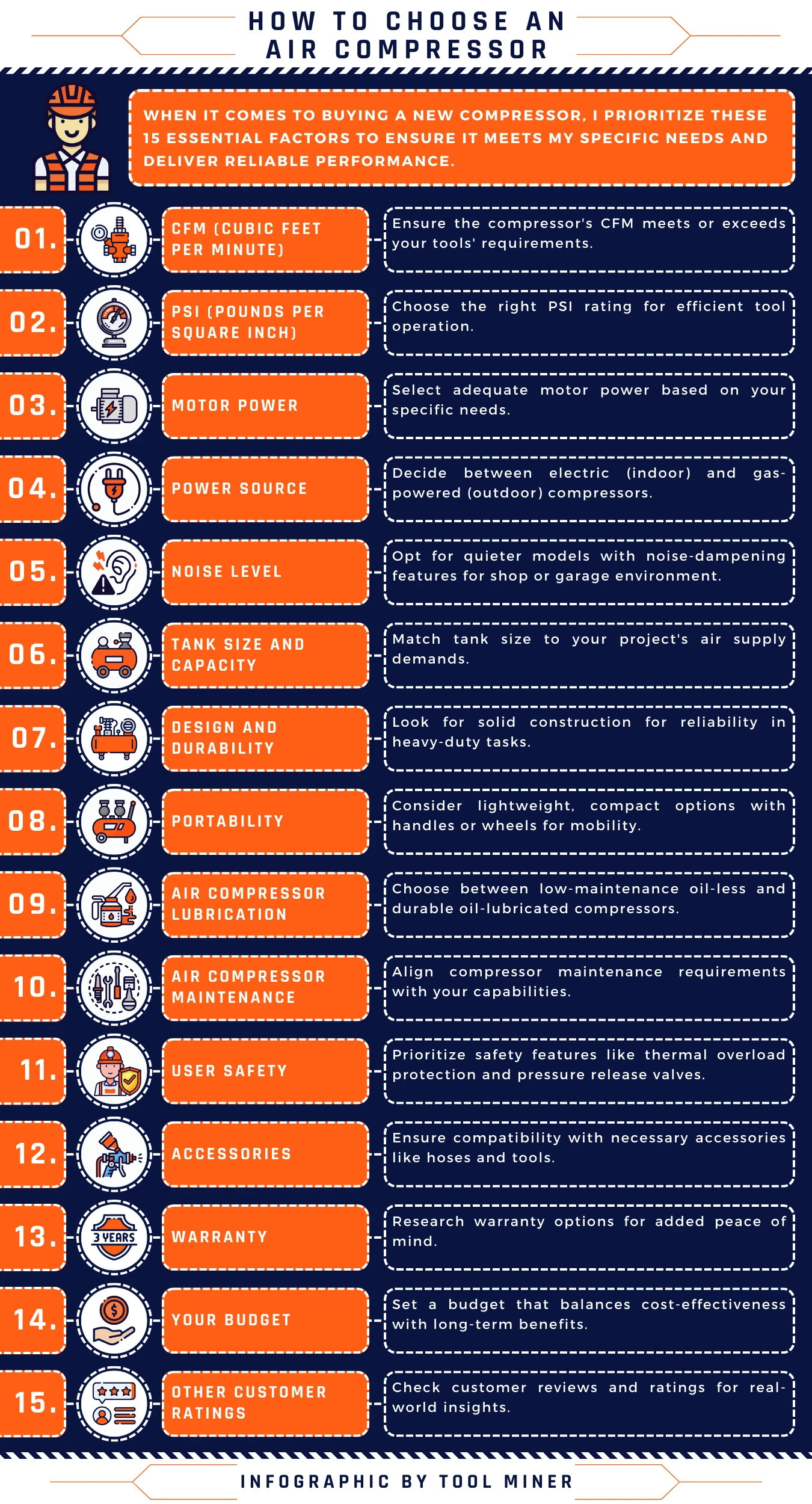Unveiling the Mystery: What is an Air Compressor and How Does It Work? [2024 Guide]
An air compressor is a versatile tool that compresses the air around us, turning it into a powerful force that can be harnessed for various applications.
From inflating tires and operating pneumatic tools to powering industrial machinery, an air compressor plays a crucial role in our various industries.
But how does it work? I invite you to Join me and my DIYer team… I am your friendly Tool Companion and DIYer “Han”.
We’ll delve deep into the inner workings of an air compressor and uncover what is an air compressor. Its history, components, applications, benefits, and which factors you should consider when buying a compressor.
I’ll be also adding my humble experience and expertise to this discussion. Now, let’s begin with the basics.
What is an Air Compressor?
An air compressor is a mechanical/pneumatic device that converts power from an external source, such as an electric motor or an internal combustion engine, into potential energy stored in the form of compressed air.
It consists of various components working together to compress and deliver air at a desired pressure level.
What is the Purpose of an Air Compressor?
The main purpose of an air compressor is to generate a steady supply of compressed air, which can then be used for various applications in different industries.
Whether in construction, manufacturing, automotive repair, or even at home like you and me doing DIY chores in our garages. An air compressor is an invaluable tool that provides a reliable source of power for a wide range of tasks.
Viktor Popp And History Of Air Compressor
The roots of this magnificent machine go back to Paris the famous city and capital of France.
In the year 1888, the Austrian engineer Viktor Popp created the first Compressor Plant. In only three years, his plant grew from 1,500 kW to 18,000 kW.
And this is just one step in the amazing history of air compressors. An epic Journey from the Humble Bellows to today’s modern air compressors is an interesting thing to know about.
These modern machines have come so far and are being used in a wider range of applications today. They are now divided into different types based on their work and functioning.
I have discussed all that below. Right now let’s get into the working of these beasts. We’ll check different parts of the air compressor working together harmoniously.
How Does An Air Compressor Work?
To understand how an air compressor works, we need to delve into the inner workings of its components.
The main parts of an air compressor include the compressor motor, pump, tank, pressure switch, and various valves and fittings.
Each component plays a crucial role in the overall functionality of the air compressor.
Air Compressor Motor: The Power Source
The motor of an air compressor provides the power needed to drive the compressor pump. It can be an electric motor or an internal combustion engine, depending on the type and size of the air compressor.
The motor converts electrical or fuel energy into mechanical energy, which is then used to turn the pump and compress the air.
Air Compressor Pump: The Heartbeat
The compressor pump is the heart of an air compressor. It is responsible for drawing in air, compressing it, and delivering it at the desired pressure. The pump consists of a piston or a set of rotating blades that create a vacuum to pull in air.
As the piston or blades move, they compress the air in a chamber, increasing its pressure. The compressed air is then discharged into a tank or storage vessel, ready to be used for various applications.
Air Compressor Tank: The Storage Reservoir
The tank or storage vessel is where the compressed air is stored. It acts as a reservoir, allowing the air compressor to generate a continuous supply of compressed air.
The tank also helps to stabilize the pressure and reduce the workload on the compressor pump. When the compressed air is released, it flows out of the tank through various valves and fittings, ready to be used for specific applications.
Other Important Air Compressor Parts
There are also air compressor parts that work in conjunction with the main parts. These include the pressure switch, types of valves, various controls, and gauges.
Air Compressor Pressure Switch
The pressure switch monitors the pressure level in the tank and automatically shuts off the compressor when the desired pressure is reached.
These pressure switches come in various types for different compressors. They can be easily replaced when they have problems.
You can easily wire a pressure switch but, do it if you know how, or call compressor repair or maintenance service near you.
Air Compressor Safety Valves
These valves are designed to release excess pressure, preventing the tank from over-pressurizing and potentially rupturing.
Air Compressor Gauges And Controls
Controls and gauges allow the user to adjust and monitor the pressure, ensuring the safe and efficient operation of the air compressor.
Different Types Of Air Compressors
Now, here you and I are gonna explore the different types of air compressors and their specific features and applications.
Air compressors come in various types, each designed for specific applications and operating conditions.
The type of air compressor you choose will depend on factors such as the required pressure level, air volume, portability, type of work, and power source.
Let’s take a closer look at some of the most common types of air compressors:
Positive Displacement Compressors
These types of compressors generate power by Air Displacement. The air is forced into one or more compression chambers, which are then closed through an inlet.
Then the volume of these chambers is gradually decreased or reduced in size to compress and pressurize the air. After the pressure reaches the built-in pressure limit, the valve is opened to release the air into the outlet system.
Based on this displacement mechanism, there are sub-types of positive displacement air compressors. Below I have elaborated on them as well.
Reciprocating Air Compressors (Piston Air Compressors)
The top on the list are reciprocating air compressors also known as piston compressors. They are one of the most widely used positive displacement compressors.
They use a piston and cylinder arrangement to compress the air. When the piston moves downward, it creates a vacuum that draws air into the cylinder. As the piston moves upward, it compresses the air, increasing its pressure.
Reciprocating air compressors are available in single-stage and two-stage compressors, offering different pressure and flow rate capabilities.
- Single-Stage Air Compressor
- Two-Stage Air Compressor
There are major differences in power, CFM, PSI, portability, price, and many other factors between single and two-stage air compressors.
The main thing I wanna tell you is that in single-stage compressors, the air is compressed only a single time between the tool nozzle and inlet valve. In a two-stage compressor, the air is compressed two times for double the pressure.
Rotary Screw Air Compressors
Rotary screw air compressors use two interlocking helical screws to compress the air. As the screws rotate, they trap and compress the air between them, gradually reducing the volume and increasing the pressure.
These types of compressors are typically big and heavy-duty with few models needing lubrication while others are oil-free.
These rotary screw compressors are known for their high efficiency, continuous operation, and low maintenance requirements.
They are commonly used in industrial applications that require a constant and reliable source of compressed air.
Scroll Air Compressors
Scroll air compressors use two spiral-shaped scrolls to compress the air. One scroll remains stationary, while the other orbits around it. As the orbiting scroll moves, it traps and compresses the air, delivering it at a higher pressure.
Scroll compressors are compact, quiet, and suitable for applications that require a continuous and steady supply of compressed air. Such as in the food, air conditioning, refrigeration, and transportation industries.
Dynamic Compressors
Axial Air Compressors
I find Axial Air Compressors a bit unique because of their working mechanics. These are gas compressors with extremely high speeds and have a larger flow rate. In these mammoths, the air flows axially or parallel to the axis of rotation.
The compressor itself has a cascade of radially arranged rotating rotor blades and stationary diffuser blades. The gas flows into the intake ports and is propelled through these rotor blades.
These air compressors are in small diameter compared to other air compressor types. That’s why they are used in jet engines and ships where continuous large volumetric flow rates are needed.
Centrifugal Air Compressors (Turbo Air Compressors)
Centrifugal air compressors also known as turbo compressors utilize centrifugal force to compress the air. They consist of a high-speed impeller that accelerates the air and a diffuser that converts the kinetic energy into pressure.
Centrifugal compressors are known for their high flow rates and energy efficiency. In addition to that, they can generate up to 1000 Horsepower. It’s typical for these compressors as their Horsepower ranges from 300 to 30,000 HP.
The thing that amazes me the most is they require less maintenance compared to reciprocating and rotary screw compressors.
That’s why, they are mostly used in large-scale industrial applications where high volumes of compressed air are required. Such as in heavy construction sites, steel manufacturing, and chemical plants.
Air Compressor Types Based On Different Technologies
I have been working with these compressors for over a decade. In these 10 years, I have used multiple compressors for my different woodworking DIY projects.
I have arranged and organized them on my DIY compressor list. I have categorized all these air compressors based on the type of work and how much power and capacity they have.
Portable Air Compressors (Small Air Compressors)
Portable or small air compressors are designed for on-the-go applications where mobility and convenience are essential. They are typically smaller in size and lightweight, making them easy to transport and operate.
They can be powered by electricity, gas, or diesel depending on the specific model. Their tank capacity ranges from 6-gallon, 10-gallon, and 15-gallon. They are commonly used in construction sites, automotive repair shops, and DIY projects.
Aside from these typical power sources, I recommend you also look for cordless air compressors. Yup, these mates work on battery power. But, what I have found is that these are designed for small DIY tasks.
Quiet Air Compressors
In simple words, I love these compressors because they are incredibly silent. I appreciate the CAT California Air Tools and Makita company as they have designed these compressors.
I know because I have a loudmouth in my uncle’s cabinet. He is also a woodworker and our families live together so I tend to go in his cabinet when I have time.
And believe me, whenever he starts his compressor I feel like I am on a construction site. So, having a quiet air compressor is a real blessing.
Car Air Compressors (Tire Inflators)
Tire inflators are not your everyday air pumps. Instead, these are small portable compressors used for automotive work, especially for inflating tires. I always suggest using cordless tire inflators for cars and bikes.
There are also heavy-duty inflators for larger vehicles such as RVs, Trailers, and SUVs. They have high CFM and PSI power, but, they are pricey as well.
Large Air Compressors
As for heavy-scale jobs, I recommend compressors with higher CFM and tank capacities. Such as 20-gallon, 30-gallon, 60-gallon, and 80-gallon compressors. In these beasts, you can also get reciprocating single-stage and 2-stage air compressors.
You can also choose based on the power source you need. Either you can get a gas air compressor or you can select an electric air compressor.
These compressors are best suited for shop work. The reason is they are quite heavy, a bit louder, and stationary as well.
These heavy-duty compressors also need proper lubrication due to their work to perform efficiently. I advise you to use synthetic compressor oil instead of motor oil or ordinary compressor oil.
If you are a Garage DIYer then you need a portable, lightweight garage air compressor. These are compact and have enough CFM, PSI, and HP for DIY and Woodworking projects.
Another thing I wanna advise you is to learn and know the different applications of these compressors. As you have seen there are many types of air compressors used in different industries based on their application.
It’ll help you select the right type of air compressor for your specific needs. So, you can ensure optimal performance and efficiency.
Applications Of Air Compressors
Air compressors have a wide range of applications in various industries. Their versatility and power make them indispensable tools for many tasks. Let’s take a look at some of the common applications of air compressors:
Powering Up Pneumatic Tools
Air compressors are extensively used to power pneumatic tools such as air wrenches, nail guns, sanders, drills, and impact wrenches. These tools rely on compressed air to generate the force needed for their operation.
Air-powered tools or pneumatic tools are preferred in many industries due to their high power-to-weight ratio, durability, and ease of use.
From construction sites and automotive repair shops to woodworking and metalworking industries, these pneumatic tools powered by air compressors are widely used for various tasks.
Below is a list of pneumatic tools that are used by experts across different work fields.
- Airbrush
- Paint Sprayers
- Air Hammers/Chisels
- Nailers/Nail Guns
- Pneumatic Staplers/Staple Guns
- Grease Gun
- Air Blow Gun
- Ratchets
- Air Impact Wrenches
- Rotary Tools/Grinders
- Air Nibblers
- Air Shear
- Air Riveter
- Air Screwdriver
- Air Speed Saw
- Air Reciprocating Saw
- Air Cut-Off Tool
- Sanders
- Needle Scaler
- Bead Breaker
All of these air tools come with CFM and PSI demand. So, I advise you to check your air compressor size chart whenever you use one of these tools.
If you wanna know my tool arsenal then Nailers, Staplers, and Impact wrenches are the ones I use in my woodworking projects.
Inflating Tires And Sports Equipment
As I have told you above air compressors are commonly used for different types of inflation work. Such as inflating tires on vehicles, bicycles, motorcycles, and other modes of transportation. They provide a quick and efficient way to achieve the desired tire pressure.
They are also used to inflate sports equipment such as footballs, basketballs, soccer balls, and inflatable water toys. With the right attachments and gauges, air compressors make tire and equipment inflation a breeze.
HVAC Systems
Heating, ventilation, and air conditioning (HVAC) systems often rely on air compressors for their operation. Air compressors play a crucial role in cooling systems, where they help to circulate refrigerant and compress it to the required pressure.
Furthermore, they are used in air conditioning systems to power fans, different types of blowers, and air handlers. Air compressors ensure efficient and reliable operation of HVAC systems, providing comfortable indoor environments in homes, offices, and commercial buildings.
Industrial Manufacturing
In the manufacturing industry, air compressors are used for a wide range of applications. They power machinery and equipment such as pneumatic actuators, robotic arms, conveyors, and assembly lines.
These beasts provide the necessary force and energy to perform tasks such as lifting, clamping, cutting, and spraying. They are essential in industries such as automotive manufacturing, metal fabrication, food processing, and pharmaceutical production.
Spray Painting And Finishing
Air compressors are widely used in spray painting and finishing applications. They provide the necessary pressure to atomize paint or coating materials and deliver a fine mist onto surfaces.
Air-powered spray guns offer precise control and even coverage, making them ideal for automotive painting, furniture finishing, and other applications that require a professional and high-quality finish.
Cleaning And Maintenance
Air compressors are also used for cleaning and maintenance tasks. The power air blow guns are used to blow away dust, debris, and moisture from surfaces and equipment.
In addition to that they are also used to clean filters, unclog drains, and remove dirt and grime from hard-to-reach areas.
Their high-pressure air stream is effective in removing stubborn dirt and contaminants, making cleaning and maintenance tasks easier and more efficient.
These are just a few examples of the many applications of air compressors. The versatility and power of compressed air make it a valuable resource in countless industries.
From construction and manufacturing to automotive and maintenance, air compressors are essential tools that enable a wide range of tasks and operations.
The next thing I wanted to talk to you about is the advantages these buddies give us and why it is a worthwhile investment.
Air Compressor Benefits
Using an air compressor offers numerous benefits that make it a worthwhile investment for both personal and professional use. Let’s take a closer look at some of the advantages of using an air compressor:
Power And Versatility
Air compressors provide a reliable source of power that can be harnessed for a wide range of applications. Whether it’s powering pneumatic tools, operating machinery, or inflating tires, compressed air offers a high power-to-weight ratio and versatility.
With the right attachments and accessories, air compressors can be used for various tasks, making them an invaluable tool in different industries.
Efficiency And Productivity
Air-powered tools and equipment are known for their efficiency and productivity. They offer a faster and more precise operation compared to their electric counterparts.
The same applies to air compressors provide a continuous and steady supply of compressed air, allowing tools to operate at their optimal performance.
This leads to increased productivity and reduced downtime, resulting in cost savings and improved efficiency.
Cost Savings
While the initial cost of an air compressor may seem significant, it can lead to long-term cost savings.
Air-powered tools are generally more durable and require less maintenance compared to electric tools. They have fewer moving parts, which means less wear and tear.
Air compressors also tend to have a longer lifespan, reducing the need for frequent replacements. Additionally, using compressed air can be more energy-efficient than other power sources, resulting in lower energy consumption and reduced utility bills.
User Safety
Air compressors offer several safety advantages. They eliminate the risk of electric shock since there is no direct electrical connection to the tools. Air-powered tools are also less likely to overheat, reducing the risk of burns or fire hazards.
Furthermore, using air compressors for certain tasks, such as cleaning or painting, can help minimize exposure to harmful chemicals or fumes.
Safety features such as pressure switches and safety valves ensure safe operation and prevent potential accidents.
Noise Reduction
Compared to electric motors, air compressors tend to produce less noise during operation. This is especially beneficial in environments where noise pollution needs to be minimized, such as residential areas or indoor workplaces.
Lower noise levels contribute to a more comfortable and productive working environment, reducing the risk of noise-related health issues.
Along with using a quiet compressor you can also use different accessories to reduce compressor noise i.e., vibration pads, mufflers, or making a DIY soundproof box.
Portability And Convenience
Portable small air compressors offer the convenience of on-the-go use. They are compact and lightweight, making them easy to transport and operate in different locations.
These air compressors can be powered by electricity, gasoline, or diesel, providing flexibility and convenience for various applications.
Whether it’s inflating tires on a roadside emergency or powering tools at a remote job site, portable air compressors offer unmatched portability and convenience.
These are just a few of the many benefits of using an air compressor. The power, versatility, efficiency, and safety advantages make air compressors an indispensable tool in numerous industries.
Factors To Consider When Choosing An Air Compressor
Now, I wanna highlight one of the most important questions. What are the factors to consider when choosing an air compressor? Plus, how to ensure that you select the right one for your specific needs?
I wanna make sure that you don’t make the costly mistakes that I made. You should always consider these factors when selecting an air compressor for your specific needs.
Below I have written down the list and infographic of important factors that I look for when I am going to buy a new air compressor.
- CFM (Cubic Feet per Minute): Ensure the compressor’s CFM meets or exceeds your tools’ requirements.
- PSI (Pounds per Square Inch): Choose the right PSI rating for efficient tool operation.
- Motor Power: Select adequate motor power based on your specific needs.
- Power Source: Decide between electric (indoor) and gas-powered (outdoor) compressors.
- Noise Level: Opt for quieter models with noise-dampening features.
- Tank Size and Capacity: Match tank size to your project’s air supply demands.
- Design And Durability: Look for solid construction for reliability in heavy-duty tasks.
- Portability: Consider lightweight, compact options with handles or wheels for mobility.
- Lubrication: Choose between low-maintenance oil-less and durable oil-lubricated compressors.
- Air Compressor Maintenance: Align compressor maintenance requirements with your capabilities.
- User Safety: Prioritize safety features like thermal overload protection and pressure release valves.
- Accessories: Ensure compatibility with necessary accessories like hoses and tools.
- Compressor Warranty: Research warranty options for added peace of mind.
- Your Budget Considerations: Set a budget that balances cost-effectiveness with long-term benefits.
- Read Customer Reviews: Check customer reviews and ratings for real-world insights.
That’s up for today… Let me know your thoughts in the comment section.
What is an Air Compressor FAQs
Which air compressor do I need?
Air compressors vary in CFM ratings, typically falling between 10 to 110 CFM. Lower CFM air compressors are suitable for small tools and car tire inflation. Higher CFM compressors are designed for industrial applications, OTR tire inflation, and large tools like 1” impact wrenches and jackhammers.
What air compressor for nail gun?
The air compressor you need for a nail gun depends on the type and size of the nail gun. For small to medium-sized air tools, a compressor with a rating of 4.0+ CFM should suffice. If you’re using a finish and trim tool individually, a 2.0+ CFM compressor should provide enough power. Generally, a 20-gallon compressor works well for nail guns.
What air compressor do I need for an impact wrench?
To power an impact wrench efficiently, you should choose an air compressor with an airflow rating of at least 3/2 times the tool’s minimum requirement. For example, if your impact wrench needs 5 CFM airflow at 90 psi, your compressor should have a rating of 7.5 CFM at 90 psi.
How air compressor pressure switch works?
An air compressor pressure switch works by starting the motor and pressurizing the compressor. When it reaches the specified system pressure, a diaphragm inside the pressure switch pushes against a mechanism, separating the electrical contacts and stopping the motor.
Why air compressor not working?
Air compressors may not work due to various reasons, including a lack of electrical power or insufficient air pressure in relation to the cut-in pressure settings. Check the cut-in pressure settings and ensure there’s enough oil.
Can air compressor run with a bad capacitor?
No, an air compressor won’t run properly with a bad capacitor, as it provides power to the compressor. A malfunctioning capacitor affects the compressor’s operation and cooling efficiency.
Are air compressor hoses universal?
Air compressor hoses serve a universal purpose in connecting the compressor to tools. However, consider variables like hose materials, couplers, and airflow when shopping for one.
Can air compressor tanks explode?
Yes, air compressor tanks can explode, often due to substantial corrosion of the tank, or if the compressed air pressure reaches a dangerous level due to malfunction.
Should you release air from an air compressor?
Venting the air through the tank valve, facing downward, for the last 40-60 lbs of air helps remove remaining moisture. Leaving the valve open and facing down helps keep the tank dry inside.
Is an air compressor worth it?
Yes, an air compressor is a versatile and cost-effective tool for various applications, making it a valuable addition to your home toolkit.
How long should you keep an air compressor?
The lifespan of an industrial air compressor can range from 15,000 to 20,000 hours before significant repairs or replacements are needed, with an overall life expectancy of around 25 years.
Which air compressor for spray painting?
Most professionals recommend using an air compressor with a CFM rating of at least 12 for spray painting. It’s crucial to choose a compressor that exceeds the CFM requirements specified for your spray gun.
How air compressor is used for cleaning?
An air compressor is used for cleaning through pressure washing. Combining air compressor power with water provides an efficient cleaning method, as the force of water, along with its mass, effectively removes dirt particles and clumps residue for easy evacuation.

